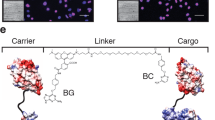Abstract
The topical delivery of transgenes to hair follicles has potential for treating disorders of the skin and hair. Here we show that the topical administration of liposome-DNA mixtures (lipoplex) to mouse skin and to human skin xenografts resulted in efficient in vivo transfection of hair follicle cells. Transfection depended on liposome composition, and occurred only at the onset of a new growing stage of the hair cycle. Manipulating the hair follicle cycle with depilation and retinoic acid treatment resulted in nearly 50% transfection efficiency–defined as the proportion of transfected, newly growing follicles within the xenograft. Transgenes administered in this fashion are selectively expressed in hair progenitor cells and therefore have the potential to affect the characteristics of the follicle. These findings form a foundation for the future use of topical lipoplex applications to alter hair follicle phenotype and treat diseases of the hair and skin.
This is a preview of subscription content, access via your institution
Access options
Subscribe to this journal
Receive 12 print issues and online access
$209.00 per year
only $17.42 per issue
Buy this article
- Purchase on Springer Link
- Instant access to full article PDF
Prices may be subject to local taxes which are calculated during checkout




Similar content being viewed by others
References
Cotsarelis, G., Sun, T.T. & Lavker, R.M. Label-retaining cells reside in the bulge area of pilosebaceous unit: implications for follicular stem cells, hair cycle, and skin carcinogenesis. Cell 61, 1329–1337 (1990).
Lyle, S. et al. The C8/144B monoclonal antibody recognizes cytokeratin 15 and defines the location of human hair follicle stem cells. J. Cell Sci. 111, 3179–3188 (1998).
Argyris, T. Kinetics of epidermal production during epidermal regeneration following abrasion in mice. Am. J. Pathol. 83, 329–340 (1976).
Paus, R. & Cotsarelis, G. The biology of hair follicles. N. Engl. J. Med. 341, 491–497 (1999).
Van Scott, E. & Ekel, T. Geometric relationships between the matrix of the hair bulb and its dermal papilla in normal and alopecia scalp. J. Invest. Dermatol. 41, 269–273 (1958).
Slominski, A. & Paus, R. Melanogenesis is coupled to murine anagen: toward new concepts for the role of melanocytes and the regulation of melanogenesis in hair growth. J. Invest. Dermatol. 101, 90S–97S (1993).
Li, L. & Hoffman, R.M. The feasibility of targeted selective gene therapy of the hair follicle. Nat. Med. 1, 705–706 (1995).
Cotsarelis, G. The hair follicle: dying for attention. Am. J. Pathol. 151, 1505–1509 (1997).
Felgner, P.L. et al. Lipofection: a highly efficient, lipid-mediated DNA-transfection procedure. Proc. Natl. Acad. Sci. USA 84, 7413–7417 (1987).
Nicolau, C. & Sene, C. Liposome-mediated DNA transfer in eukaryotic cells: dependence of the transfer efficiency on the type of liposome used, and the host cell stage. Biochem. Biophys. Acta 721, 185–190 (1982).
Wilson, C. et al. Cells within the bulge region of mouse hair follicle transiently proliferate during early anagen: heterogeneity and functional differences of various hair cycles. Differentiation 55, 127–136 (1994).
Chase, H. Growth of the hair. Physiol. Rev. 34, 113–126 (1954).
Paus, R., Stenn, R. & Link, R. Telogen skin contains an inhibitor of hair growth. Br. J. Dermatol. 122, 777–784 (1990).
Alexander, M.Y. & Akhurst, R.J. Liposome-mediated gene transfer and expression via the skin. Hum. Mol. Gen. 4, 2279–2285 (1995).
Yu, W.H. et al. Topical gene delivery to murine skin. J. Invest. Dermatol. 112, 370–375 (1999).
Sato, N., Leopold, P.L. & Crystal, R.G. Induction of the hair growth phase in postnatal mice by localized transient expression of Sonic hedgehog. J. Clin. Invest. 104, 855–864 (1999).
Egilmez, N.K., Iwanuma, Y. & Bankert, R.B. Evaluation and optimization of different cationic liposome formulations for in vivo gene transfer. Biochem. Biophys. Res. Commun. 221, 169–173 (1996).
Sorgi, F.L., Bhattacharya, S. & Huang, L. Protamine sulfate enhances lipid-mediated gene transfer. Gene Ther. 4, 961–968 (1997).
Shi, Z., Curiel, D.T. & Tang, D-c. DNA-based non-invasive vaccination onto the skin. Vaccine 17, 2136–2141 (1999).
Fan, H., Lin, Q., Morrissey, G.R. & Khavari, P.A. Immunization via hair follicles by topical application of naked DNA to normal skin. Nat. Biotechnol. 17, 870–872 (1999).
Gilhar, A., Ullmann, Y., Berkutzki, T., Assy, B. & Kalish, R.S. Autoimmune hair loss (alopecia areata) transferred by T lymphocytes to human scalp explants on SCID mice. J. Clin. Invest. 101, 62–67 (1998).
Wrone-Smith, T. & Nickoloff, B.J. Dermal injection of immunocytes induces psoriasis. J. Clin. Invest. 98, 1878–1887 (1996).
Safavi, K.H., Muller, S.A., Suman, V.J., Moshell, A.N. & Melton, L.J. Incidence of alopecia areata in Olmsted County, Minnesota, 1975 through 1989. Mayo Clin. Proc. 70, 628–633 (1995).
Van Scott, E.J. Morphologic changes in pilosebaceous units and anagen hairs in alopecia areata. J. Invest. Dermatol. 31, 35–43 (1958).
Headington, J.T. & Novak, E. Clinical and histologic studies of male pattern baldness treated with topical minoxidil. Curr. Ther. Res. 36, 1098–1106 (1984).
Acknowledgements
We thank Dr. Leaf Huang for valuable discussions and Ms. Dorothy Campbell for excellent technical assistance. This work was supported by grants from the National Alopecia Areata Foundation.
Author information
Authors and Affiliations
Corresponding author
Rights and permissions
About this article
Cite this article
Domashenko, A., Gupta, S. & Cotsarelis, G. Efficient delivery of transgenes to human hair follicle progenitor cells using topical lipoplex. Nat Biotechnol 18, 420–423 (2000). https://doi.org/10.1038/74480
Received:
Accepted:
Issue Date:
DOI: https://doi.org/10.1038/74480
This article is cited by
-
Development of a Two-Dimensional Model for Predicting Transdermal Permeation with the Follicular Pathway: Demonstration with a Caffeine Study
Pharmaceutical Research (2017)
-
Strengthening the Skin with Topical Delivery of Keratinocyte Growth Factor-1 Using a Novel DNA Plasmid
Molecular Therapy (2014)
-
Cutaneous Drug Delivery: An Update
Journal of Investigative Dermatology Symposium Proceedings (2013)
-
The use of polyethylenimine–DNA to topically deliver hTERT to promote hair growth
Gene Therapy (2012)



